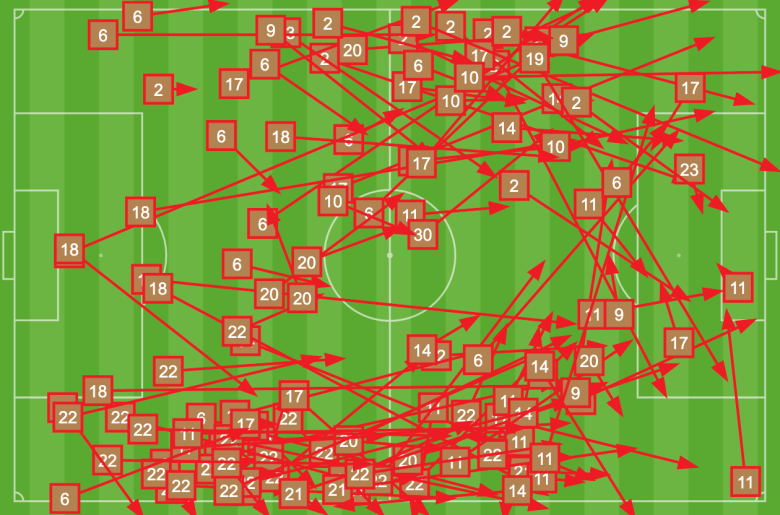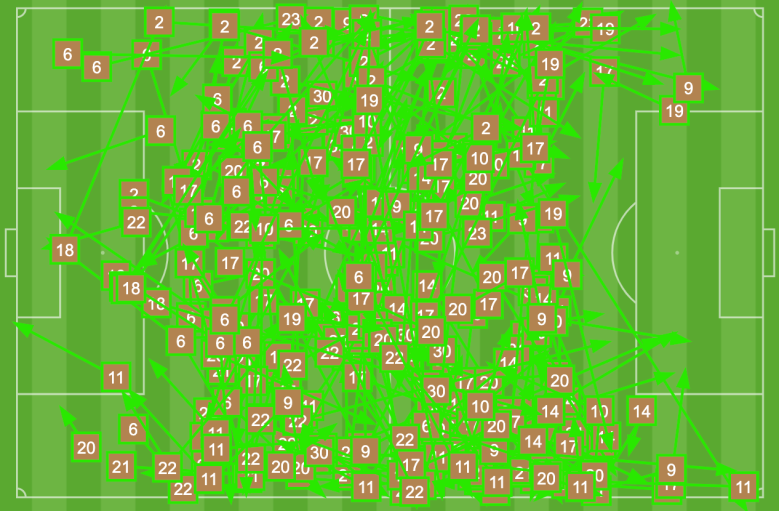Welcome to The Graphical, wherein I mine the Opta data for insights about how and why Nashville SC’s most recent game turned out the way it did. Today, a 0-1 disappointment in First Tennessee Park.
Get the lead, hit the bunker
Tampa Bay has given up four goals this year (in 10 games! That’s incredible). Only one of those has come after they’ve already taken a lead – a late equalizer by Louisville City FC.
How does that happen? Well, let’s take a look at what the Rowdies’ defensive positioning looked like over the course of the game. How about I break it into two segments?
Here are the positions of their central defenders (including those who subbed into the lineup), with prior to the goal on the left side, and after it on the right. As you can see, the Rowdies know how to protect a lead: maintain extremely conservative defensive positioning, preventing the opponent from having any opportunity to work into dangerous areas.
Was Nashville’s struggle frustrating? Of course. Was it also a little on the understandable side when you consider that an already-elite defensive team is doing that? Of course.
Playing wide, having a tough time
Check out this map of Nashville SC’s incomplete passes in the game:

That’s a lot of wide play, and a lot of wide play that didn’t work out. It also doesn’t include unsuccessful crosses (of which there were 21!). That’s a lot of playing the game very wide, and a lot of not having much success with that.
That’s one of the things that just happens with the 3-5-2, as it pushes those wingbacks to the touchline (NSC’s strikers also pulled wide at times to try to get on the ball). You can tell from the fact that the left side of the field (top) that there was either more passing success there, or a different gameplan – I pointed out during the contest that Justin Davis would push a little higher as Taylor Washington played like a left midfielder, rather than a wingback, at times:
That should theoretically help balance the lines a bit, giving more options than “wingback bangs in a cross,” but it didn’t work out hyper-well in this game.
The successful passes were more evenly distributed both in terms of height up the pitch, and across the width of it:

Nashville SC actually possessed the ball a reasonable amount in the all important Zone 14 (at the top of Tampa’s box), but the passes from within that area weren’t successfully completed into even more advantageous areas. Indeed, you can see that a frustrating number of them went back wide – another consequence of Tampa’s solid defense.
All that combines to mean crosses
Here’s the piece that logically follows from the above two bullet points (Tampa stays compact, Nashville tried to keep the ball wide and pushed it back wide from within the attacking third): there was a lot of crossing, and much of it was not successful – as tends to be the case with cross-heavy gameplans. They’re inherently low-percentage plays*
That’s centerback Justin Davis (recast a bit as a traditional fullback, as I described above) with a bunch of crosses, wingback slash left midfielder Taylor Washington with a few himself, and then right wingbacks Darnell King and Kharlton Belmar combining for most of the work on the bottom (all but one of Belmar’s came after switching to wingback from the striker position he began the game in).
Nashville would prefer not to play this way, but they were, to some degree, forced into it by the opposing 3-5-2 formations.
* So why cross if it’s not super-successful? Because it’s available (particularly against a three-man backline), for the most part. If you are given the flank by the opposing defense, you have the opportunity to get the ball into the box and sort of hope it just works out for you. If you can pump in a bunch of crosses, you can generate a ton of low-percentage chances, which is easier to come by than few high-percentage chances.
Sloppy in the final third
One last thing, again with a bit of overlap from the previous sections, because I think thematically, we’re honing in on what made the game turn out the way it did. Here are Nashville’s passes from Zone 14
 That’s a couple key passes leading to very long shots, one key pass into the box, and otherwise mostly incomplete passes into the box, or complete ones pushing it laterally or even backwards. Again, that combines with the above-mentioned factoids.
That’s a couple key passes leading to very long shots, one key pass into the box, and otherwise mostly incomplete passes into the box, or complete ones pushing it laterally or even backwards. Again, that combines with the above-mentioned factoids.
What happened on those incomplete passes though? This is anecdotal, since I haven’t clipped GIFs yet (and may not have time before the next game!), but it seemed all too frequent that they were reasonably accurate, and the intended recipient either didn’t expect the ball, or expected another runner coming in behind him.
“At some stage there’s got to be some creativity, and I think maybe what you’re seeing is some disguise in an individual’s play hoping that there’s a connection and they can break through those lines,” Gary Smith said when I asked about it. “It’s not easy. I’ve watched some top games – as we all have – over the last weeks or months, and there’s plenty of very very good teams that find it incredibly difficult when they go a goal down to break down a good defensive unit.”
With Nashville’s team, the “it takes a while to develop chemistry” excuse is on its way out in terms of being valid. At a certain point, even a side with multiple new players in key positions has to find that connection. Daniel Ríos has played the vast majority of meaningful minutes this Summer, most of them alongside Matt LaGrassa, Michael Reed, and the others who provide service to the strikers (most of whom have been together for more than a year). Even shifting formations can only explain away so much of the lack of connection. At a certain point, the players simply have to be able to get on the same page.




